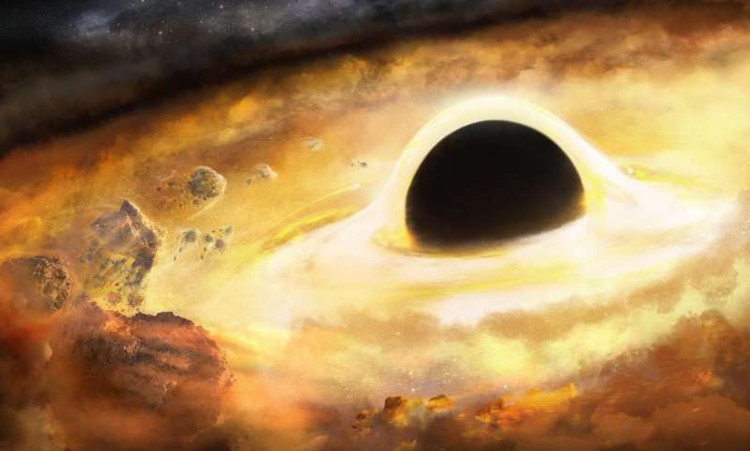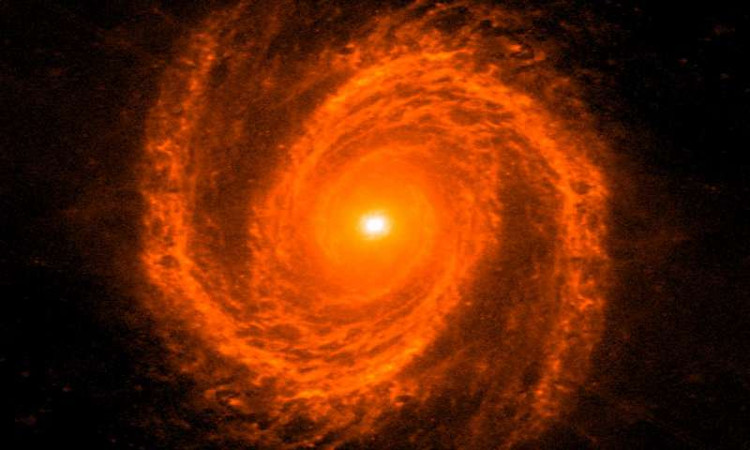Find out how to weigh black holes: use galaxy spiral arms
This is extremely easy, so that elementary students can do it.
Astronomers from Swinburne University of Technology, Australia and the University of Minnesota Duluth, USA, have found a way to help "armchair astronomers" who only work in their offices not in the observatory - and also elementary school students, just looking at a spiral branch of the galaxy is able to calculate the mass of the central black hole hidden behind it. This study was supported by the Australian Research Council, and published in the Monthly Notices of the Royal Astronomical Society journal. (The Moon of the Royal Astronomical Society).

Black holes that never emit light are recognizable.
Because black holes that never emit recognizable light, they are often studied through high-tech observations of stars and atmospheres around their orbits, thereby providing a reasonable measure of how big they are.
The good news is that the latest studies based on measures that appear earlier have shown that the mass of black holes can be estimated merely by observing its host galaxy arms .
Nearly a century ago, James Jeans and Edwin Hubble had noticed that spiral galaxies with large bulges in the center possessed spiral arms tightly bound together, while galaxies spiraled with The small bulge shows the spiral arms extending out. Since then, hundreds of thousands, if not millions of spiral galaxies have been classified according to the Sa, Sb, Sc, Sd patterns, based on the shape of its spiral arms.
Professor Marc Seigar, Associate Dean of the Swenson School of Science and Engineering at the University of Minnesota Duluth, and co-author of this study, discovered the relationship between the mass of the central black hole and the bile. the tightness of the twisted branches of a galaxy nearly a decade ago.

The "Sab" galaxy, called Messier 81, is located on the northern constellation of Ursa Big, and has a mass of black holes about 68 million times the sun.
Dr. Benjamin Davis and Professor Alister Graham, from Swinburne Superhuman and Astrophysics Center have led this new study to restore the connection between black hole mass and spiral branch geometry.
False when carefully analyzing larger samples of galaxies, captured by an array of space telescopes, researchers observed a surprisingly strong relationship, and one That number predicts lower-mass black holes in the galaxy will have open spiral arms (Model Sc and Sd).
"The power of this relationship may be competitive, if not better, with any other method used to predict the mass of black holes," Dr Davis said. "Anyone can look at the image of a spiral galaxy, and immediately assess how big the black hole is behind it."
Because the "disks" of the galaxy are what make up twisted patterns, the study also stresses that the relationship so far is little known, between galaxies and black holes. Moreover, this process allows to predict the mass of black holes in pure galaxies with bulging segments filled with constellations."This implies that the black holes and their host galaxies are probably evolutionary at the same time," Dr Davis said.

Spiral arms with different levels of tightness, and central black hole masses and corresponding galaxies in the mass units of our galaxy. This sample can be used to estimate the mass of black holes in a spiral galaxy.
"Importantly, this connection also allows studying medium-mass black hole communities (about 100 to 100,000 times larger than the sun), which are suspected to be missing at the present time. It is difficult to detect when their mass is much larger than any single star, but smaller than the huge black lot, billions of times heavier than our sun " , Professor Graham said.
- Discover the largest pair of black holes near Earth
- Millions of black holes are hiding in our galaxy
- The three galaxies unite to
- Discovered missing branches of the Milky Way
- The four spiral arms of the Milky Way
- The galaxy has 3 black holes
- Detecting spiral galaxies in the early universe
- The supermassive black hole 'carnivores' from the inside
- Discover the mystery of the most exotic black holes in the universe
- Detecting new black holes with very strong firepower
- Milky Way has only 2, not 4 arms
- 26 new black holes in Tien Nu galaxy
 Van Allen's belt and evidence that the Apollo 11 mission to the Moon was myth
Van Allen's belt and evidence that the Apollo 11 mission to the Moon was myth The levels of civilization in the universe (Kardashev scale)
The levels of civilization in the universe (Kardashev scale) Today Mars, the sun and the Earth are aligned
Today Mars, the sun and the Earth are aligned The Amazon owner announced a secret plan to build a space base for thousands of people
The Amazon owner announced a secret plan to build a space base for thousands of people Black holes create mysterious swirling 'structures' that could open 'gateways' into dark matter
Black holes create mysterious swirling 'structures' that could open 'gateways' into dark matter  Surprising facts about the black panther - the inspiration for the character Black Panther
Surprising facts about the black panther - the inspiration for the character Black Panther  The nearest black hole discovered is only 150 light years from Earth
The nearest black hole discovered is only 150 light years from Earth  New discovery of the oldest black hole in the universe
New discovery of the oldest black hole in the universe  The Black Pyramid and the tragedy of deep oblivion: A thousand years later, still no escape from the tragedy of tomb raiding
The Black Pyramid and the tragedy of deep oblivion: A thousand years later, still no escape from the tragedy of tomb raiding  Exploring the 'Black Box of the Earth' project: A device that records the process of human extinction
Exploring the 'Black Box of the Earth' project: A device that records the process of human extinction 